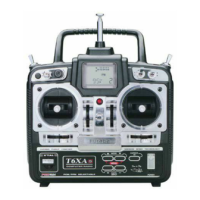10. Dihedral Method 1: Fly the model on
normal pass and roll into
knife-edge flight; maintain
flight with top rudder (do this
test in both left & right knife-
edge flight)
Method 2: Apply rudder in
level flight
A. Model has no tendency to roll
B. Model rolls in direction of applied
rudder
C. Model rolls in opposite direction in
both tests
A. Dihedral OK
B1. Reduce dihedral
B2. Use mixer to produce
aileron opposing rudder
travel (start with 10%)
C1. Increase dihedral
C2. Mix ailerons with rudder
direction 10%
11. Elevator
alignment (for
models with
independent
elevator halves)
Fly the model as in Test 6 and
pull up into an inside loop.
Roll it inverted and repeat the
above by pushing it up into an
outside loop.
A. No rolling tendency when elevator
applied
B. Model rolls in same direction in both
tests — halves misaligned.
C. Model rolls opposite directions in
both tests. One elevator half has
more throw than the other (model
rolls to side with most throw).
A. Elevators in correct
alignment
B. Either raise one half, or
lower the other
C. Reduce throw on one side,
or increase throw on the
other.
12. Pitching in
knife-edge flight
Fly the model as in Test 10 A. There is no pitch up or down
B. The nose pitches up (the model
climbs laterally)
C. Nose pitches down (model dives
laterally)
A. No adjustment needed
B. Alternate cures:
1) move CG aft;
2) increase incidence;
3) droop ailerons;
4) mix down elevator with
rudder
C. Reverse ‘B’ above
*Trim tab is 3/16” x 3/4” x 4” trailing edge stock, placed just in front of aileron on bottom, pointed end forward.
– 25 –

